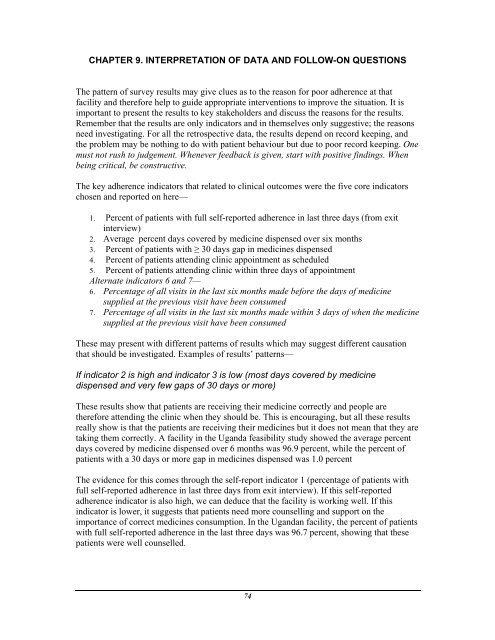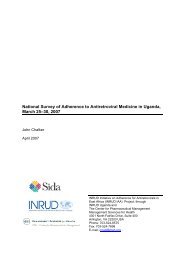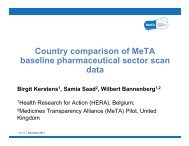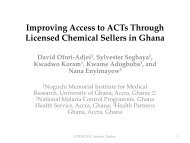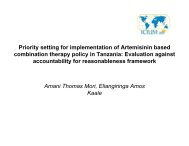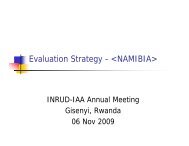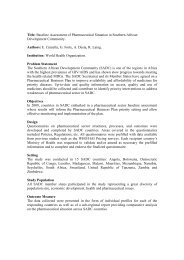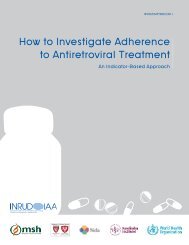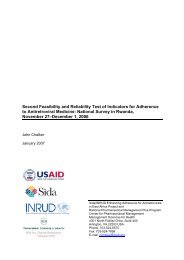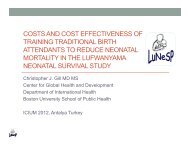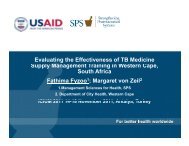How to investigate Adherence to Antiretroviral Treatment ... - INRUD
How to investigate Adherence to Antiretroviral Treatment ... - INRUD
How to investigate Adherence to Antiretroviral Treatment ... - INRUD
You also want an ePaper? Increase the reach of your titles
YUMPU automatically turns print PDFs into web optimized ePapers that Google loves.
CHAPTER 9. INTERPRETATION OF DATA AND FOLLOW-ON QUESTIONS<br />
The pattern of survey results may give clues as <strong>to</strong> the reason for poor adherence at that<br />
facility and therefore help <strong>to</strong> guide appropriate interventions <strong>to</strong> improve the situation. It is<br />
important <strong>to</strong> present the results <strong>to</strong> key stakeholders and discuss the reasons for the results.<br />
Remember that the results are only indica<strong>to</strong>rs and in themselves only suggestive; the reasons<br />
need investigating. For all the retrospective data, the results depend on record keeping, and<br />
the problem may be nothing <strong>to</strong> do with patient behaviour but due <strong>to</strong> poor record keeping. One<br />
must not rush <strong>to</strong> judgement. Whenever feedback is given, start with positive findings. When<br />
being critical, be constructive.<br />
The key adherence indica<strong>to</strong>rs that related <strong>to</strong> clinical outcomes were the five core indica<strong>to</strong>rs<br />
chosen and reported on here—<br />
1. Percent of patients with full self-reported adherence in last three days (from exit<br />
interview)<br />
2. Average percent days covered by medicine dispensed over six months<br />
3. Percent of patients with ≥ 30 days gap in medicines dispensed<br />
4. Percent of patients attending clinic appointment as scheduled<br />
5. Percent of patients attending clinic within three days of appointment<br />
Alternate indica<strong>to</strong>rs 6 and 7—<br />
6. Percentage of all visits in the last six months made before the days of medicine<br />
supplied at the previous visit have been consumed<br />
7. Percentage of all visits in the last six months made within 3 days of when the medicine<br />
supplied at the previous visit have been consumed<br />
These may present with different patterns of results which may suggest different causation<br />
that should be <strong>investigate</strong>d. Examples of results’ patterns—<br />
If indica<strong>to</strong>r 2 is high and indica<strong>to</strong>r 3 is low (most days covered by medicine<br />
dispensed and very few gaps of 30 days or more)<br />
These results show that patients are receiving their medicine correctly and people are<br />
therefore attending the clinic when they should be. This is encouraging, but all these results<br />
really show is that the patients are receiving their medicines but it does not mean that they are<br />
taking them correctly. A facility in the Uganda feasibility study showed the average percent<br />
days covered by medicine dispensed over 6 months was 96.9 percent, while the percent of<br />
patients with a 30 days or more gap in medicines dispensed was 1.0 percent<br />
The evidence for this comes through the self-report indica<strong>to</strong>r 1 (percentage of patients with<br />
full self-reported adherence in last three days from exit interview). If this self-reported<br />
adherence indica<strong>to</strong>r is also high, we can deduce that the facility is working well. If this<br />
indica<strong>to</strong>r is lower, it suggests that patients need more counselling and support on the<br />
importance of correct medicines consumption. In the Ugandan facility, the percent of patients<br />
with full self-reported adherence in the last three days was 96.7 percent, showing that these<br />
patients were well counselled.<br />
74


